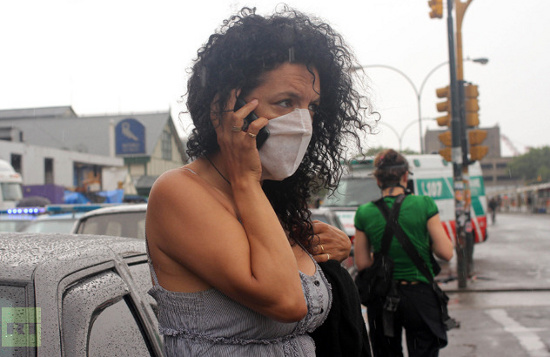The people of Argentina evacuated because of toxic smoke
Poison smoke spread throughout Argentina's capital yesterday, causing people in many areas to evacuate.
>>>Video: The scene of toxic smoke spread in Buenos Aires

A woman uses a nose plug to block toxic smoke in the city of Buenos Aireis on December 6.
A container of pesticides at the port of Buenos Aires exploded on December 7, a spokesman for the Argentine Ministry of Health said. Before the explosion of this container is placed in the dangerous cargo area. Smoke from the explosion flew to the center of the city and headed south to make people use cloth to prevent smoke from reaching the nose. Many office workers in the city center said they could not breathe normally and had to wear a special mask to evacuate, Telegraph reported.
Smoke spread to Lanus, about 15km from Buenos Aires. Every hospital in the city is put on alert. The city government advised people in some areas to stay inside and close the doors. However, people in some other areas have to evacuate. TV station reported that many people were hospitalized.
"I feel dizzy in itching in the eye," one man said.
City officials assured people that smoke in the city was not poisonous."People should not worry. The smoke is so thin that it does not cause harm to health," said Javier Corcuera, head of the Environmental Protection Agency.
Reference: Telegraph
- Secret of preventing toxic smoke when the apartment is burnt
- Smoke is more toxic than cigarette smoke
- The more fragrant incense smoke, the more curved the incense is, the more toxic and easy to cause cancer
- Indonesians massively evacuated for volcanoes
- Thousands of Germans evacuated for poisonous clouds
- Marijuana smoke contains more toxins than cigarette smoke
- Video: Breathing in toxic New Delhi like smoking 50 cigarettes
- The village of 'mutants' can eat poisonous drama
- The toxic chemicals were discovered in the fire and smoke of the forest
- Why is smoke in a fire easy to kill?
- How to provide first aid when gas suffers
- Argentina successfully invented plastic from corn and cassava
 Is the magnetic North Pole shift dangerous to humanity?
Is the magnetic North Pole shift dangerous to humanity? Washington legalizes the recycling of human bodies into fertilizer
Washington legalizes the recycling of human bodies into fertilizer Lightning stone - the mysterious guest
Lightning stone - the mysterious guest Stunned by the mysterious sunset, strange appearance
Stunned by the mysterious sunset, strange appearance